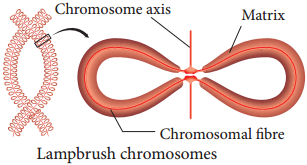Learninsta presents the core concepts of Biology with high-quality research papers and topical review articles.
Nucleus Definition and Various Types of Functions
Nucleus is an important unit of cell which controls all activities of the cell. Nucleus holds the hereditary information. It is the largest among all cell organelles. It may be spherical, cuboidal, ellipsoidal or discoidal. It is surrounded by a double membrane structure called nuclear envelope, which has the inner and outer membrane.
The inner membrane is smooth without ribosomes and the outer membrane is rough by the presence of ribosomes and it continues with irregular and infrequent intervals with the endoplasmic reticulum.
The membrane is perforated by pores known as nuclear pores which allows materials such as mRNA, ribosomal units, proteins and other macromolecules to pass in and out of the nucleus. The pores enclosed by circular structures called annuli. The pore and annuli form the pore complex. The space between two membranes is called perinuclear space.
Nuclear space is filled with nucleoplasm, a gelatinous matrix has uncondensed chromatin network and a conspicuous nucleolius. The Chromatin network is an uncoiled, indistinct and remain thread like during the interphase. It has little amount of RNA and DNA bound to histone proteins in eukaryotic cells (Figure 6.22).
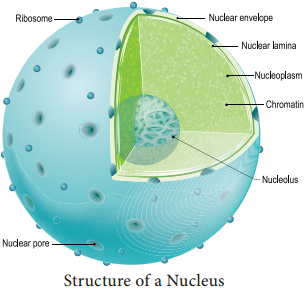
During cell division chromatin is condensed into an organized form called chromosome. The portion an eukaryotic chromosome which is transcribed into mRNA contains active genes that are nottightly condensed during interphase is called Euchromatin.
The portion of an eukaryotic chromosome that is not transcribed into mRNA which remains condensed during interphase and stains intensely is called Heterochromatin. Nucleolus is a small, dense, spherical structure either present singly or in multiples inside the nucleus and it’s not membrane bound. Nucleoli possess genes for rRNA and tRNA.
Functions of the Nucleus
- Controlling all cellular activities
- Storing the genetic or hereditary information.
- Coding the information from DNA for the production of enzymes and proteins.
- DNA duplication and transcription takes place in the nucleus.
- In nucleolus ribosomal biogenesis takes place.
Chromosomes
Strasburger (1875) first reported its present in eukaryotic cell and the term ‘chromosome’ was introduced byWaldeyerin 1888. Bridges (1916) first proved that chromosomes are the physical carriers of genes. It is made up of DNA and associated proteins.
Structure of Chromosome
The chromosomes are composed of thread like strands called chromatin which is made up of DNA, protein and RNA. Each chromosome consists of two symmetrical structures called chromatids. During cell division the chromatids forms a well organized chromosomes with definite size and shape.
They are identical and are called sister chromatids. A typical chromosome has narrow zones called constrictions. There are two types of constrictions, namely primary constriction and secondary constriction. The primary constriction is made up of centromere and kinetochore.
Both the chromatids are united at centromere, whose number varies. The monocentric chromosome has one centromere and the polycentric chromosome has many centromeres. Centromere contains a complex system of protein fibres called kinetochore. Kinetochore is the region of chromosome which is attached to the spindle fibre during mitosis.
Besides primary there are few secondary constrictions, are present. Nucleoli develop from these secondary constrictions are called nucleolar organizers. Secondary constrictions contain the genes for ribosomal RNA which induce the formation of nucleoli and are called nucleolar organizer regions (Figure 6.23).
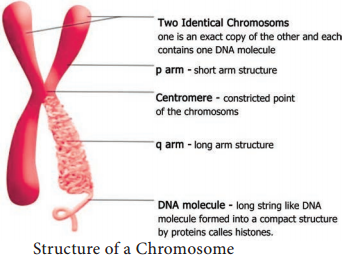
A satellite or SAT Chromosome is a short chromosomal segment or rounded body separated from main chromosome by a relatively elongated secondary constriction. It is a morphological entity in certain chromosomes.
Telomere is the terminal part of chromosome. It offers stability to the chromosome. DNA of the telomere has specific sequence of nucleotides. Telomere in all eukaryotes are composed of many repeats of short DNA sequences (5’TTAGGG3’ sequence in Neurospora crassa and human beings).
Maintenance of telomeres appears to be an important factor in determining the life span and reproductive capacity of cells, so studies of telomeres and telomerase have the promise of providing new insights into conditions such as ageing and cancer. Telomeres prevent the fusion of chromosomal ends with one another.
Types of Chromosomes
Based on the position of centromere, chromosomes are called telocentric (terminal centromere), acrocentric (terminal centromere capped by telomere), sub metacentric (centromere subterminal) and metacentric (centromere median). The eukaryotic chromosome may be rod shaped (telocentric and acrocentric), L-shaped (sub-metacentric) and V-shaped (metacentric) (Figure 6.24).
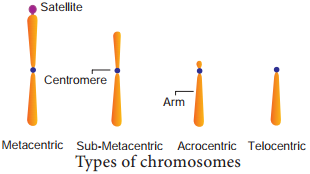
Based on the functions of chromosome it can be divided into autosomes and sex chromosomes. Autosomes are present in all cells controlling somatic characteristics of an organism. In human diploid cell, 44 chromosomes are autosomes whereas two are sex chromosomes. Sex chromosomes are involved in the determination of sex.
Special Types of Chromosomes
These chromosomes are larger in size and are called giant chromosomes in certain plants and they are found in the suspensors of the embryo. The polytene chromosome and lamp brush chromosome occur in animals and are also called as giant chromosomes.
Polytene chromosomes observed in the salivary glands of Drosophila (fruit fly) by E.G. Balbiani in 1881. In larvae of many flies, midges (Dipthera) and some insects the interphase chromosomes duplicates and reduplicates without nuclear division.
A single chromosome which is present in multiple copies form a structure called polytene chromosome which can be seen in light microscope. They are genetically active. There is a distinct alternating dark bands and light inter-bands. About 95% of DNA are present in bands and 5% in inter-bands.
The polytene chromosome has extremely large puff called Balbiani rings which is seen in Chironomous larvae. It is also known as chromosomal puff. Puffing of bands are the sites of intense RNA synthesis. As this chromosome occurs in the salivary gland it is known as salivary gland chromosomes. Gene expression, transcription of genes and RNA synthesis occurs in the bands along the polytene chromosomes.
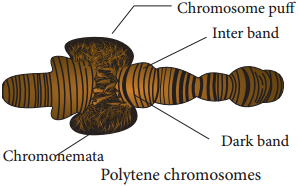
Lampbrush chromosomes occur at the diplotene stage of first meiotic prophase in oocytes of an animal Salamandar and in giant nucleus of the unicellular alga Acetabularia. It was first observed by Flemming in 1882. The highly condensed chromosome forms the chromosomal axis, from which lateral loops of DNA extend as a result of intense RNA synthesis.
